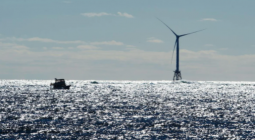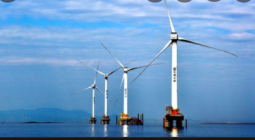Concern over impact of Norfolk Boreas offshore windfarm on seabirds

Project backed by Boris Johnson likely to get go-ahead but is on site that rare birds travel though, campaigners say
A major new windfarm project that will power millions of homes is likely to be approved on Friday, but conservationists fear for the safety of endangered birds in the area.
The Norfolk Boreas offshore windfarm is due to get the green light from the government, the Guardian can reveal.
The windfarm is said to be being backed by Boris Johnson who, government sources claim, is so keen on the project that he refers to himself as “Boreas Johnson” in meetings about it. The Department for Business, Energy and Industrial Strategy (BEIS) source claimed that Johnson was extra keen on the project because of his love of Greek mythology – Boreas was the ancient Greek god of the north wind. It is said the prime minister hopes this can be a flagship green energy project that could make Britain the “Saudi Arabia of wind power”.
The windfarms planned for the Norfolk coast – Boreas and another project, Vanguard – are estimated to be able to power 10% of UK homes – around 3.9million UK homes. Wind power contributed 24.8% of UK electricity supplied in 2020, having surpassed coal in 2016 and nuclear in 2018. To meet a net zero pledge in 2030, more windfarms need to be built, as this is currently the UK’s most significant source of renewable energy.
However, the north Norfolk coast is home to some of Britain’s most significant colonies of endangered sea birds including kittiwakes, gannets and lesser black-backed gulls. There are concerns from the Royal Society for the Protection of Birds that the blades could kill the birds. On top of this the project involves disrupting the area where the birds feed, and making it more difficult to travel from the ocean to their nests. If it takes the birds too long to fly back to their young, the chicks can starve to death.
An RSPB source said the site has difficulties because of the number of rare birds that feed, travel through and nest in the area. “Ultimately we need to get away from sites with unavoidable problems. Which is in the gift of the Crown Estate, as the seabed belongs to the Queen,” he said.
“We are very concerned about the cumulative impact of all these turbines in one space. The secretary of state has ‘accepted’ other windfarms will impact on seabirds in this area (some globally important colonies for kittiwakes and others) – and the mitigation methods being proposed are untried and untested, so it could well be over a decade before we know if they will be successful, by which time the damage will have been done to the colony.”
A source at BEIS confirmed the windfarm is expected to be approved.
The windfarm, which is to be built by the Swedish firm Vattenfall, has also faced complaints from people in Norfolk, who say the vast cabling required to construct the project would be disruptive to their homes. Some 85 parish councils have written to BEIS to express opposition to the plans.
The Vanguard project was recently blocked in the high court after a resident argued the joint impact of Vanguard and Boreas would be too disruptive to his home and that the secretary of state had not taken into account the effect of both. The application must now go back to the government for reassessment, according to the Planning Inspectorate.
Vattenfall said in a statement: “Offshore wind will be the backbone of our energy system as we tackle climate change. By 2050, it’s estimated that renewable energy will provide 80% of our electricity needs, and much of this will need to come from offshore windfarms.
“Norfolk Vanguard and Norfolk Boreas are part of the next generation of windfarms. By working with communities, the supply chain, skills and environmental experts, we have designed projects that can bring real lasting benefits – to Norfolk and the UK.
“These windfarms will bring £15m of funding for local communities, and will be in place for the 25-year life of the windfarms. This is the largest funding commitment to Norfolk by an offshore wind company to date.”
It argues that biodiversity is at the forefront of its plans: “Each windfarm has its own bespoke monitoring and habitat management plan, developed through the planning process with input from expert groups.
“This work constantly improves our understanding of the ways in which wildlife and habitats responds and adapts to wind farms, and helps to inform our research programmes.”






